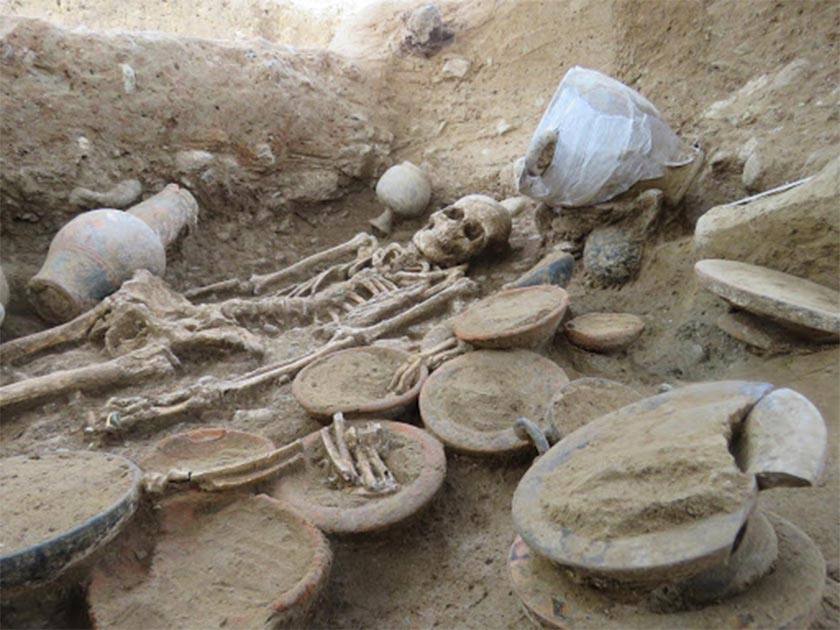Rare Etruscan Tomb of Treasures Excavated in Corsica
Over the last few months as the world was slowly shutdown with the prevailing pandemic, a team of archaeological and anthropological researchers led by Franck Leandri, head curator of the French National Institute of Preventive Archaeological Research (Inrap), discovered a Roman and Etruscan necropolis including an exceptional 4th century BC Etruscan tomb, at Aléria, a commune in the Haute-Corse department of France on the east side of island of Corsica.
Carved into solid bedrock, when the ancient tomb was excavated the archaeologists recovered a hoard of ceramic vessels resembling Etruscan pieces from Tuscany, and in a hypogeum located at the center of the tomb, ceremonial furniture was found to have collapsed over the remains of the woman who was laid to rest on her back. With her arms extended along the body and her head tilted slightly to the left, her remains contained a pair of gold earrings and two copper and gold alloy finger rings.

View of the Etruscan burial chamber and the stairs and the corridor of the hypogeum. (Roland Haurillon, Inrap)
Advanced Pre-Excavation Preservation Procedures
With no written records, archaeologists only know the broad strokes about Etruscan culture: that they had originated in Tuscany during the Bronze Age around 900 BC and that after a gradual decline, the last Etruscan cities were absorbed by Rome around 100 BC. But now, according to an article in Archaeology.org, Leandri said the tomb will help his team of scholars “better understand the decline of Etruscan cities.”
Among the more spectacular grave goods discovered in the tomb were two perfume vases, known formally as alabastrons, which were found lying on the feet of the buried woman. A collection of small black-varnished goblets, two damaged “bronze mirrors” and a dozen drinking goblets of different shapes and sizes were discovered aligned along the sides of the woman’s body.
But before even a grain of dust was removed from the site, after the initial discovery this exceptionally-well preserved tomb, a Bible of equally exceptional preservation measures were designed for digging out the fragile ceramics.

View of oenochoes (jugs) in situ showing Etrurian produced paintings dating from the 4th cent. BC (Roland Haurillon, Inrap)
Scared Grave Goods At The Elite Etruscan Tomb
The team of scientists afforded great attention to studying the sedimentary layers trapped within the ancient vases as they were removed from the tomb. In total, 22 ancient ceramics were analyzed through non-intrusive CT scanning and 3D images were generated revealing microscopic data pertaining to the material composition of the dense concentrations of sediment. And after the preservation project had excavated and assembled the collection of artifacts, the ‘post-excavation’ phase of the research began requiring every artifact to be cleaned, stabilized and catalogued.
The first results of the CT analyses revealed some unpredicted outcomes that “surprised” the archaeologists, including an alabaster containing a metal rod which is thought to have been a perfume or ointment stick. A large skyphos (two-handled deep wine-cup) was found containing a small cup, and a smaller skyphos contained a “difficult to identify object.” What’s more, one of the cups situated near the feet of the woman’s body contained a small bronze ring, one of five discovered in this tomb, and another had been placed inside a fabric or basketry container that rotted away many centuries ago.
- Tabula Cortonensis: A 2,200-year-old Tablet with a Bronze Key to Understanding the Etruscan World
- 171,000-Year-Old Fire Forged Tool Discovered Beneath a Giant Elephant
- The Codex Amiatinus: The Skins of 500 Calves Were Used to Create this Monumental Manuscript

In the foreground various bowls and cups with animal remains under study, and in the background a mirror, three skyphoi,an alabaster and two painted oenochoes (jugs) (Roland Haurillon, Inrap)
Tomb Of An Ancient Goddess?
A report on Reuters says the discovery of this tomb will illustrate how ancient populations in Corsica flourished and they will also tell archaeologists about the slow demise of the Etruscan civilization and how exactly their End of Days unfolded. Head curator Franck Leandri says the tomb, and its treasures, are “the missing link” which will not only allow the piecing together of scattered Etruscan funerary rites but reinforces the popular hypothesis that before the Roman conquest of 259 BC, Aleria was a major “transit point in the Tyrrhenian Sea, blending Etruscan, Carthaginian and Phocaean interests”.
Anthropologist Catherine Rigeade told Reuters that in conclusion, the ancient tomb appears to have belonged to a high-ranking official female who was surrounded with about 15 ceramic vases including what appears be two rare bronze mirrors. And the next phase of this fascinating research project will now focus on these two exceptional, yet heavily damaged, bronze mirrors, along with a fine bone handle which the researchers think might both be related to some kind of ritualist bathing, or sacred environment relating to a goddess, lost in the fires of the expanding Roman empire.
Top image: View of the Etruscan burial chamber. In the foreground bowls and animal remains and towards the back the deceased. Source: Roland Haurillon / Inrap
By Ashley Cowie



















